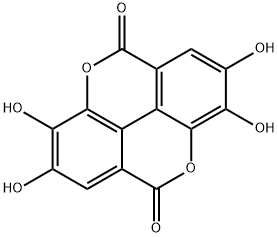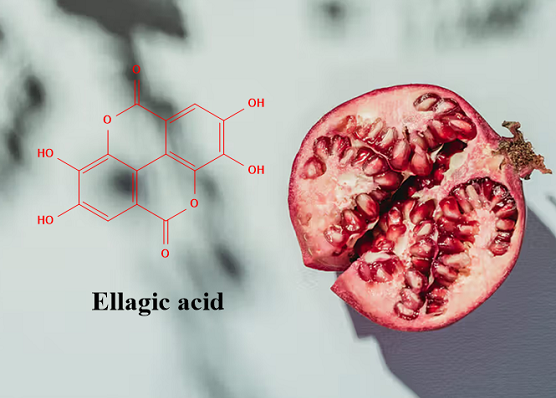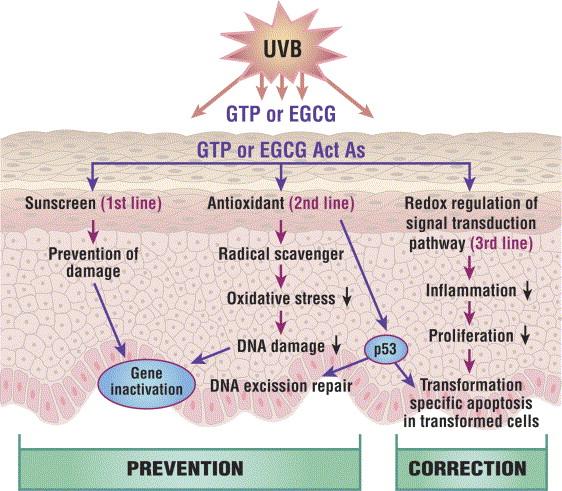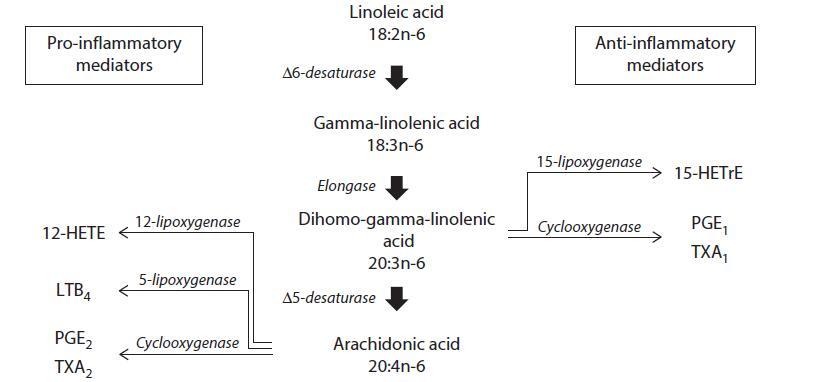Uses in Cosmetics of Ellagic acid
Overview
Ellagic acid is a polyphenol compound (Figure 5.1) found in several fruits and nuts, such as raspberries, grapes, strawberries, pomegranates, and walnuts. Several studies have described its antiproliferative and apoptotic effects on certain cancer cell lines. Similar to other polyphenolic phytochemicals, ellagic acid also demonstrates antioxidant effects in several in vitro and in vivo models. Results from studies investigating the dermatological applications of ellagic acid are promising as well. Specifically, ellagic acid may be effective in improving signs of UV-induced skin aging9 and treating hyperpigmentation.
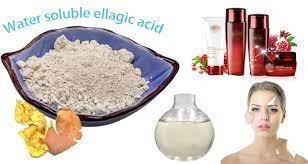
UV-Induced Skin Aging
The mechanism by which ellagic acid may protect UV-induced skin damage is multifactorial. Available evidence suggests that ellagic acid reduces UV-induced production of matrix metalloproteinases that lead to collagen degradation. Moreover, ellagic acid upregulates nuclear factor erythroid 2-related factor 2 (Nrf2), a transcription factor that controls the expression of several genes encoding antioxidative proteins and cytoprotective mechanisms.
Evidence regarding the effectiveness of ellagic acid in preventing photodamage is limited (Table 5.1). A recent study showed that SKH-1 hairless mice topically treated with ellagic acid (10 μmol/L) had less skin wrinkling compared to untreated mice after eight weeks of UVB exposure. Human clinical trials evaluating the effectiveness of topical ellagic acid as a preventive or reactionary treatment for photodamage are needed.
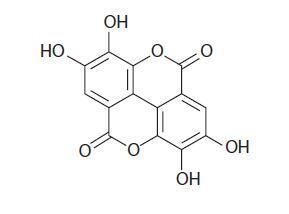
FIGURE 5.1 The structure of ellagic acid.
Hyperpigmentation
Tyrosinase is a copper-containing enzyme that is key in melanin production. Ellagic acid decreases melanogenesis by inhibiting tyrosinase through copper chelation at the active site. Two in vivo studies suggest that ellagic acid may be effective in treating hyperpigmentation. Shimogaki et al. reported that topically applied ellagic acid (1% w/v) improved UV-induced pigmentation in brownish guinea pigs after four weeks of daily treatment.10 Yoshimura et al. demonstrated that oral administration of ellagic acid-rich pomegranate extract (100 mg/kg/day versus 1000 mg/kg/day) inhibited UV-induced pigmentation, in a dose-dependent manner, among brownish guinea pigs.
Moreover, several human clinical trials have examined the effectiveness of ellagic acid in treating hyperpigmentation (Table 5.1).12−14 A randomized, double-blind, placebo-controlled trial found that orally administered ellagic acid-rich pomegranate acid tablets (100–200 mg/day) significantly inhibited pigmentation among subjects with a slight sunburn caused by UV irradiation. Ertam et al. compared the effectiveness of synthetic 1% ellagic acid, naturally-derived 1% ellagic acid, and 1% arbutin in treating melasma in a randomized, open-label study.13 Both formulations of ellagic acid were as effective as arbutin, a well-known skin lightening agent, in improving pigment density. A recent study reported that topical 0.5% ellagic acid and 0.1% salicylic acid combination therapy was as effective as 4% hydroquinone in improving several clinical and instrumental measures of pigmentation.
Side Effects
Clinical studies have not reported any adverse events with topical application of ellagic acid.
Conclusion
Ellagic acid may have several dermatological applications. Limited available evidence suggests that ellagic acid may reduce UV-induced skin wrinkling in vivo. Additional studies are needed to characterize the clinical effectiveness of ellagic acid as a preventive or reactionary treatment for premature photoaging.
Furthermore, several studies suggest that topical and oral forms of ellagic acid may be effective in preventing and treating hyperpigmentation. Although hydroquinone is considered the standard treatment, it may be melanotoxic and can cause permanent skin depigmentation. Ellagic acid has not been found to damage melanocytes and may be a safe alternative agent.
REFERENCES
1. Kim YH, Kim KH, Han CS et al. Anti-wrinkle activity of Platycarya strobilacea extract and its application
as a cosmeceutical ingredient. J Cosmetic Sci 2010;61:211–24.
2. Usta C, Ozdemir S, Schiariti M, Puddu PE. The pharmacological use of ellagic acid-rich pomegranate
fruit. Int. J Food Sci Nutr 2013;64:907–13.
3. Larrosa M, Tomas-Barberan FA, Espin JC. The dietary hydrolysable tannin punicalagin releases ellagic
acid that induces apoptosis in human colon adenocarcinoma Caco-2 cells by using the mitochondrial
pathway. J Nutr Biochem 2006;17:611–25.
4. Weisburg JH, Schuck AG, Reiss SE et al. Ellagic acid, a dietary polyphenol, selectively cytotoxic to
HSC-2 oral carcinoma cells. Anticancer Res 2013;33:1829–36.
5. Zhao M, Tang SN, Marsh JL, Shankar S, Srivastava RK. Ellagic acid inhibits human pancreatic cancer
growth in Balb c nude mice. Cancer Lett 2013;337:210–7.
6. Qiu Z, Zhou B, Jin L et al. In vitro antioxidant and antiproliferative effects of ellagic acid and its colonic
metabolite, urolithins, on human bladder cancer T24 cells. Food Chem Toxicol 2013;59:428–37.
7. Cozzi R, Ricordy R, Bartolini F, Ramadori L, Perticone P, De Salvia R. Taurine and ellagic acid: Two
differently-acting natural antioxidants. Environ Mol Mutagen 1995;26:248–54.
8. Iino T, Nakahara K, Miki W et al. Less damaging effect of whisky in rat stomachs in comparison with
pure ethanol. Role of ellagic acid, the nonalcoholic component. Digestion 2001;64:214–21.
9. Bae JY, Choi JS, Kang SW, Lee YJ, Park J, Kang YH. Dietary compound ellagic acid alleviates skin
wrinkle and inflammation induced by UV-B irradiation. Exp Dermatol 2010;19:e182–90.
10. Shimogaki H, Tanaka Y, Tamai H, Masuda M. In vitro and in vivo evaluation of ellagic acid on melanogenesis
inhibition. Int J Cosmetic Sci 2000;22:291–303.
You may like
Related articles And Qustion
Lastest Price from Ellagic acid manufacturers
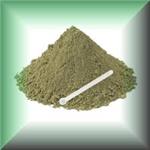
US $1200.00-1100.00/ton2025-10-14
- CAS:
- 476-66-4
- Min. Order:
- 1ton
- Purity:
- 99%
- Supply Ability:
- 1000T/M

US $0.00-0.00/KG2025-04-27
- CAS:
- 476-66-4
- Min. Order:
- 1KG
- Purity:
- 98%,90%,40%
- Supply Ability:
- 2000tons
